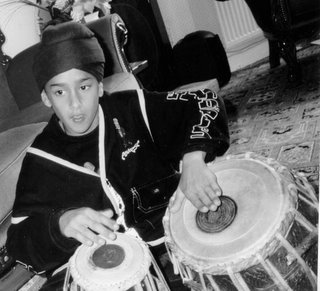
The tabla developed as a hybridized drum, influenced by all of these varieties, in particular, the mrdangm and the puskara. Muktesvara temple (6th-7th century) and Bhuranesvara (and three other cave temples) of Badari in Bombay (6th century) contain depictions of the Puskara. Musicians often placed the puskara's smaller verticle drum (called 'alinga'), on their lap and played more than one drum at a time. Given the the design, technology, and musical structure for drums common in this this period, we can piece together numerious features of the tabla.
The name 'tabla', probably derived from the Arabic word for a drum (generic), called the 'tabl'; and possibly to some extent the Turkish word 'dawal'. Another popular notion is that Amir Khursuro invented the tabla by splitting the Pakawaj into two drums. This is highly disputed. Abul Fazil, the court recorder neither mentions nor describes the tabla, leaving doubt that Amir Khursuro invented the tabla, contrary to a previously popular notion. The Muslim invaders undoubtedly influenced the culture and structure of the tabla. However, the earliest depictions and literature describing the tabla as we recognize it today come from the 18th century.
Details available from this point on enable us to chart the development to modern day. Over the last two centuries the tabla begins to take the forefront of percussion instruments in north Indian classical music. We can trace the family lineage of the gharanas from the 18th century onward. Over this time, the tabla slowly changed, the dayan decreasing in size while the bayan increased. During this time the instrument slowly became the primary drum for both classical and popular music of north India.
No comments:
Post a Comment